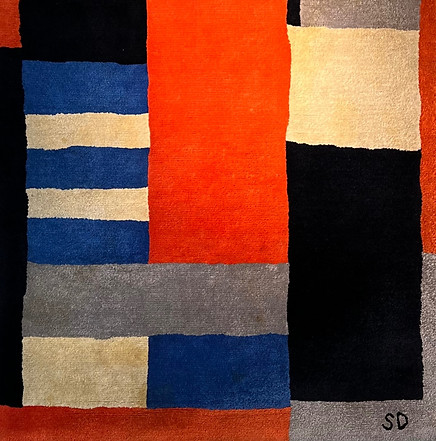SONIA DELAUNAY'S COLLABORATION WITH ARTCURIAL
Titled Varèse after Edgar Varèse (Paris, 1883- New York, 1965), this tapestry refers directly to the invention of simultanism in Music, founded by the cited composer, who bounded with visual artists of the early 20th century art movements. At the Centre Pompidou in Paris, the Kandinsky-Archives preserve correspondence proving the friendship between Varèse and the Delaunay couple, who developed simultanism in plastic arts.
According to Varèse, rhythm is the result of matter, energy and force, and is caused by the interaction of several independent and irregular levels. Sonia Delaunay applied in her artwork Varèse’s musical theory about how rhythm is based on the idea that sound objects are subject to physical forces of attraction and repulsion in space.
This particular piece is a remarkable example of Delaunay’s simultanism, showing how some colors might seem like a different color when juxtaposed and revealing through the use of contrasting and discordant palettes how these combinations of colors create an impression of movement.

Sonia Delaunay (1885-1979)
Ukrainian-born French artist
"For me there is no gap between my painting and my so-called 'decorative' work. I never considered the 'minor arts' to be artistically frustrating; on the contrary, it was an extension of my art."
Sonia Delaunay

Born in 1885 to a family with few resources, Sonia Delaunay-Terk survived both world wars, and died at the age of 94 in Paris in the year of 1979. Her artistic formation was completed in Russia and Germany, before moving to France in the year of 1905, where her artistic production was influence by the Post-Impressionist and Fauvist art movements.
Delaunay was co-founder of the french avant-garde movement Orphism, alongside her husband Robert Delaunay (1885-1941), and experimented with many other artistic styles, developing a theory of color based on scientific research known as simultanism, which she then applied to her work.
Pioneer figure of abstract painting, Sonia Delaunay tried to overcome the barriers between the Arts, merging Life and Art in her works. Being a prominent figure in the 20th century art world, Sonia Delaunay became the first female artist to have a retrospective exhibition in the Louvre (1964) during her life-time.
Sonia Delaunay, mostly known as a painter, was also a stylist and decorator, amongst other things, applying Orphism’s principles to artistic fields such as textile design, scenography and fashion, as well as jewerly and ceramic decoration.
In addition to her paintings, Delaunay designed theatre scenery and costumes for Serge Diaghilev, collaborated in the fashion industry with Coco Chanel and Blaise Cendrars during the 1920s, and pursued a series of edition projects in France and the United States in the 1930s.
In the decade of 1970, Sonia Delaunay initiated a collaboration with the French art gallery Artcurial, developing a range of textiles, table wear and jewelry inspired in the central themes of her pictorial work during the 1920s, transforming day-to-day objects and fashion accessories into artworks in its own right.

Sonia Delaunay (right) and two friends in Robert Delaunay’s studio,
Rue des Grands-Augustins, Paris, 1924.
Artcurial
Artcurial was inaugurated in June of 1975 by François Dalle, then chief of L’Oréal, in 9 Avenue Matignon, functioning as an art gallery and specialized bookstore, mainly as a publisher of multiples. Between the years of 1975 and 2002, when it was sold, Artcurial published works of 70 artists, including Armand, Sonia Delaunay, Giorgio de Chirico, Marino di Teana, Takis and François-Xavier Lalanne.
Inspired in an original concept regarding the development of plastic arts under the form of artistic objects referred to as multiples, Artcurial’s founding ideas came from Guy Landon, a L’Oréal employee since 1953, who aspired to launch a project in the Contemporary Art field.
In its twenty-five years of activity, over a thousand creations were produced with the collaboration of renowned contemporary artists — varying from sculptures, engravings, carpets and furniture to porcelain and jewerly— and offered to a wide public, who had been left out by traditional galleries. Simultaneously, Artcurial accommodated important retrospective exhibitions, allowing the public to perceive fine arts in a more intimate environment than institutional museums could provide.
Achieving such a coherent project, Artcurial became well known for its original approach to reaching the vast public, who was quickly persuaded by the gallery’s way of “giving life to art”, as put by Sonia Delaunay, one of the first female artists to collaborate with Artcurial.